

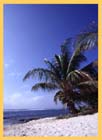 Meg Lukens Noonan, in the Premier issue of Aqua, a sister to Islands magazine, sums it up, "everyone greets everyone else. The day I drive a rental car around the island, I need one hand available at all times to return waves."
Meg Lukens Noonan, in the Premier issue of Aqua, a sister to Islands magazine, sums it up, "everyone greets everyone else. The day I drive a rental car around the island, I need one hand available at all times to return waves."This is the infectious flavor of Cayman Brac. Visitors might arrive here all steamed up and stressed, but shortly find their faces relaxed, smiling and arms waving back. A few days later and they initiate the wave.
Most people arriving on "the Brac," as we soon call it, are packing fins, mask and snorkel. With the usual 100+ foot underwater visibility, the underwater scene is a major attraction. Many visitors also have a full complement of scuba diving equipment. The Brac has some of the finest diving on the planet and for an added bonus, Brac boats can zip over to Little Cayman for the Bloody Bay Wall experience. It will take years to get "spoilt" here.
Travelers have options; some fly into Grand Cayman by a variety of carriers and connect with a late afternoon Cayman Airways flight to the Brac on Twin Otter aircraft. These flights are forty minutes to an hour long depending on whether there is a stop on Little Cayman. Island Air has four flights daily serving the Brac.
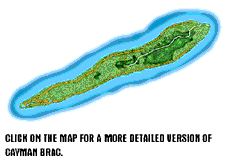
Christopher Columbus visited The Brac in 1503 and found it alive with sea turtles and small crocodile-like caymans. This, combined with the island's topography, produced the island's name. A bluff ("brac" in Gaelic) runs down the island's center line.
For a time, pirates found the island caves a delightful place to hide booty. In modern times we might talk about celebrities who've visited; perhaps Sharon Stone, Brad Pitt or Madonna. Back then, it was a Who's Who in Piracy: Blackbeard, Morgan and others.
Later, the caves were a high-ground refuge from hurricanes.
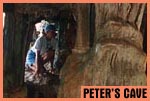 In 1932, an especially violent one wreaked havoc on the island. Most of the island's residents survived by hiding in Peter's Cave, high on a north side bluff.
In 1932, an especially violent one wreaked havoc on the island. Most of the island's residents survived by hiding in Peter's Cave, high on a north side bluff.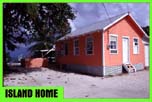 Today, there are about 1,600 residents on the Brac. Most are native Brac'rs, but the number of people buying property is growing. The island has an active real estate market. Still, it is a small island and it will be a long time before urban crowding becomes an issue.
Today, there are about 1,600 residents on the Brac. Most are native Brac'rs, but the number of people buying property is growing. The island has an active real estate market. Still, it is a small island and it will be a long time before urban crowding becomes an issue. Brac visitors have a choice of accommodations. Many second-home owners will rent their home by the week. Several hotels maintain properties along the oceanfront and there are a few rental condo complexes.
Old habits die hard, but locking one's car has become a lost art. The Brac is one of the safest and crime-free islands in the Caribbean.
Notable diving attractions are the walls of both the Brac and Little Cayman and the frigate wreck.
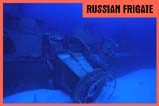
A Russian frigate was purchased from Cuba and sunk in 1996 within swimming distance of the north side of the island off the defunct Buccaneer Hotel property. It is perfectly situated for divers of all skill levels. The stern is in shallow water and the deepest section of the bow rests on the sand at about 90fsw.
Fish, large and small, are turning the wreck into home. Divers will consume a lot of compressed air before they've seen it all.
The walls around the two islands are pictures of perfection. Arches, swimthrus, cracks, gorgonia, sponges and fans all compete for a divers attention. Shine a light on the muted blue structures and the reds, yellows, oranges and purples will spin all your color wheels at once.
There aren't many restaurants on the Brac, but the ones you'll find are worth second visits. Maybe the best way to choose is by your mood. Almost all have outdoor as well as indoor dining, some are on the water, all the others are near it. The seafood will be fresh. None are formal, but you can choose a degree of elegance.
Visitors can find all three. Bikes are often provided as part of the accommodations. Scooters and cars can be rented for reasonable rates. A valid drivers license is necessary to obtain a temporary driving permit which will be valid on any of the Cayman Islands. Credit card imprints are necessary for the required deposits. Driving is on the left.
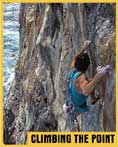
The Brac is becoming a climbing destination. The bluff has numerous sites where climbers are challenged to go from sea level to the-top-of-the-bluff. Non-climbing visitors will also be happy to have specialty footwear. Many of the places to visit will require walks along the ironshore and through scrub. Given a choice of packing boat shoes or hiking boots, opt for the boots. See the Island Attractions section for more information about climbing.
There are a few places on the Brac where you will find some interesting souvenir items such as caymanite jewelry and original island art. In general, however, the Brac is not a shopping mecca.
Water is produced by the island's reverse osmosis system and is piped or trucked to locations around the island. The source of water for rental homes might be rainfall into a cistern augmented occasionally by a truckload from the island system.
Electricity is produced on-island and is 110 VAC/60-cycle as used in the U.S.
The Cayman Islands have been closely tied to England for many years. As you would expect, English is language of all the Cayman Islands.
The US$ is accepted everywhere, however, your change may be in KY$ (Cayman Islands dollars). The exchange rate on all the Cayman Islands is fixed at KY$.80 equals US$1.00. Travelers checks and major credit cards are widely accepted.
In the summer months, May to August, expect temperatures to average around 80 degrees F. In winter months, September through April, temperatures will usually average in the mid-70s.
Visitors need proof of citizenship in the form of a passport or birth certificate. A drivers license is not acceptable. Vaccinations are not necessary to visit the Cayman Islands.
Faith Hospital and Dental Clinic are located on the west side of the island. There is also The Brac Clinic located in Tibbett's Square at the West End. The Clinic is a comprehensive private Primary Care facility which opened in 1999.
Attire in the Cayman Islands is comfortable and relaxed, however, visitors are asked to cover beachwear when visiting public places. Topless bathing and nude bathing are prohibited.
The honeymoon and diving community is fond of leaving colorful driftwood signs as a record of their visit. Many use the "Brac" or a sound-alike in their message. Because the island leaves such an impression on people, the overriding refrain is "Back To The Brac."